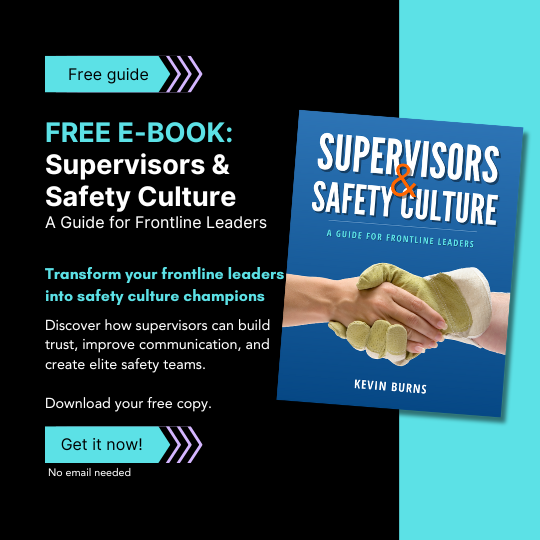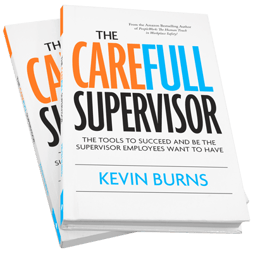Want to know how top companies get better work from their teams? Supervisors who build real connections with team members create safer workplaces, higher productivity, and employees who stay longer. Learn simple ways to help supervisors move beyond just giving orders to building relationships that help the whole business succeed.
(Bonus: download a free resource, Supervisors & Safety Culture ebook)

When supervisors only focus on tasks and numbers, they miss what drives workplace success: connecting with people. The most successful companies have found that their businesses do better when supervisors build strong relationships with workers.
While job skills matter, the supervisor's ability to build trust, show they care, and make team members feel safe to speak up truly improves productivity, safety, and worker loyalty. This difference doesn't just make people feel better—it shows up in better results and helps companies beat their competition.
Why Communication Breakdowns Occur
Communication fails in workplaces for clear reasons:
Box-Checking Instead of Connection: Many supervisors have only been trained to monitor tasks and checkboxes. They haven't learned how to build real relationships with their teams. Without this connection, messages feel cold, and workers don't fully engage.
Emotional Distance: The biggest gap isn't physical—it's emotional. Supervisors often lack the skills to show they care about their teams as people, creating walls that block even the most important messages.
Different Goals: Supervisors focus on long-term plans while team members focus on today's tasks. Without sharing the bigger picture, these different views cause problems.
Lacking Meaningful Feedback Skills: Many supervisors haven't learned how to give feedback in ways that build people up rather than tear them down. They focus on what went wrong without acknowledging what's going right, making team members defensive instead of open to improvement.
Always Putting Out Fires: Supervisors often put off talking with their team members when work gets busy. They know building relationships is important, but urgent problems take over their day. This creates a cycle where fixing problems takes priority over the connections that would stop problems from happening in the first place.
The Supervisor's Role as Relationship Builder
Great supervisors don't just manage work—they build trust bridges with their teams. Their success comes from creating a safe space where workers feel valued as people, not just for what they produce. This relationship-building role makes them essential for several reasons:
- Supervisors who connect with their teams create psychological safety. This makes workers comfortable sharing ideas and concerns without fear.
- Good supervisors don't just relay information—they translate it with empathy. They understand how changes affect their team's daily work and emotions.
- When supervisors invest in relationships first, their teams listen when it matters most. Team members follow guidance from someone they trust far more readily than from someone they barely know.
Three Communication Systems That Build Workplace Relationships
Companies with strong team connections use systems designed for human engagement, not just information transfer:
1. Daily Team Check-ins: These are short, 5-to-10-minute team gatherings where supervisors focus on work updates and how people are doing. Good supervisors use this time to recognize efforts, hear concerns, and make sure everyone feels part of the team.
2. Going to Where Workers Are: Supervisors regularly leave their offices to connect with employees in their own work areas. Team members feel more comfortable on their own turf, which leads to more honest talks. This simple practice shows respect for team members' space and expertise.
3. Making Themselves Approachable: Supervisors develop specific habits that make team members feel safe coming to them. These include staying focused on them, listening without interrupting and responding to problems without blaming. When team members see their supervisor as someone they can talk to, issues get solved before they grow bigger.
How Training Supervisors to Build Relationships Helps Business
When companies teach supervisors to connect with their team members, good things happen:
Better Safety: Companies that train supervisors to build relationships have fewer accidents. Team members who trust their supervisors speak up about unsafe conditions before someone gets hurt.
More Work Gets Done: Teams with strong connections to their supervisors get more work done. Team members try harder for leaders who show they care.
Team Members Stay Longer: People don't quit jobs where they feel valued. Companies that focus on building relationships keep their team members longer than those that only focus on getting tasks done.
Faster Problem-Solving: When problems come up, teams with good relationships fix them quicker. Team members feel safe to admit mistakes early, and everyone works together to find solutions without pointing fingers.
PeopleWork Supervisor Academy's Tools for Building Better Relationships
The PeopleWork Supervisor Academy has created simple tools that help supervisors connect with their teams right away:
Quick Daily Check-ins: Supervisors learn to have short, friendly talks with each team member every day. These aren't formal meetings but casual conversations that build trust over time. This simple habit shows team members they matter as people, not just for their work.
Really Listening: This tool teaches supervisors to pay attention when team members speak, ask good questions, and show they understand. When team members feel heard, they're more likely to share ideas and concerns.
Catching People Doing Good: This is a way to notice and praise good work every day. It helps supervisors look for what's going right instead of just focusing on problems, which makes team members feel valued.
Solving Problems with Care: Ways to fix issues by showing concern for the person, not just the problem. This approach avoids blame and helps supervisors and team members solve problems as partners.
What separates high-performing teams from struggling ones isn't found in process manuals or corporate structures—it's the quality of human connections between supervisors and their team members. Companies create workplaces where trust and information flow freely by training supervisors to build relationships first and communicate second. This helps every team member feel valued and do their best work.
When relationship-building becomes part of supervisors' leadership, the results are clear: safer workplaces, more productivity, better ideas, and more engaged workers ready to meet tomorrow's challenges.





